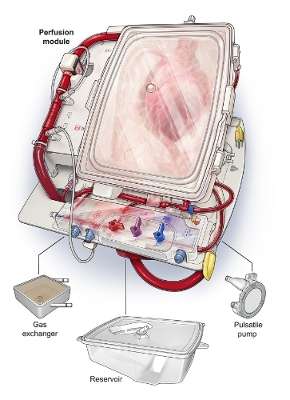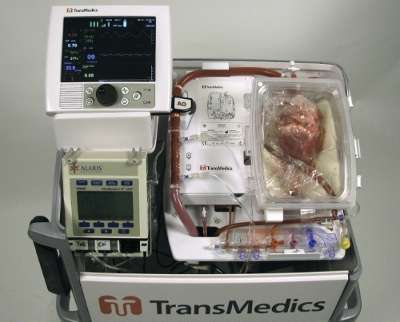The Organ Care System (OCS(TM)) Heart
(Medical Xpress)—A system that enables heart transplants involving hearts that stopped beating in the donor's body continues to save lives. The Organ Care System (OCS) has been used in UK hospitals with good results.
The device is from an Andover, Massachusetts, company, TransMedics. The company states it was founded to address the unmet need for more and better organs for transplantation.
A view of a heart beating on an OCS system is hard to forget, as it shows a donated heart beating outside the body while being with blood and oxygen.
The technology at work is in focus in a report in MIT Technology Review. Why is this system so unusual? Typically, "heart transplants only come from brain-dead donors whose hearts are cut away while their bodies are still healthy."
Antonio Regalado reported on the device used by surgeons to keep an organ of a person recently passed away. The heart is used on people who need the organ to stay alive. Regalado described it as a wheeled cart with oxygen supply, sterile chamber and tubing, "to clamp onto a donor heart and keep it fed with blood and nutrients."
Without a device such as this, hearts from dead donors are considered by surgeons as too damaged to use. With the device, said a UK surgeon, the heart gets the essential infusion of blood to restore its energy.
Earlier this year, a consultant cardiothoracic surgeon Stephen Large, who carried out such a transplant, said he believed use of the OCS could have positive implications for reducing the numbers of patients on the National Health Service waiting list for a donor heart.
Heart on the OCS System
Overall, said Dr. Waleed Hassanein, President and CEO of TransMedics earlier this year, the ability to safely transplant a donor heart from non-heart beating donors could be a paradigm shift to potentially increase the pool of viable donor hearts to help more patients suffering from end-stage heart failure.
He said at the time they were "actively engaged in four large pivotal trials for hearts, lungs and livers in the U.S" to bring the OCS technology to the U.S. market "hopefully very soon."
Regalado explained: hearts from brain-dead donors can be cooled down inside the body, stopped, removed, and shipped at near 4 °C. "Cold temperatures cut the tissue's metabolic rate by about 90 percent, creating time to reach the recipient. Nearly all transplanted organs, including kidneys, are preserved this way."
The "heart in a box," however, is part of a wider shift away from shipping organs cold to keeping them warm and functioning. In recent tests of such techniques, called warm perfusion, scientists have shown they can cut off a pig's leg then replace it 12 hours later if it receives a supply of nutrients. "Cold is the old thing, and warm is the new thing," said Korkut Uygun, a transplant surgeon at the Massachusetts General Hospital, in the MIT Technology Review report. "Warm is the way to go with metabolically active tissue."
The company said the ability to keep donor organs in a warm, "living" state outside the body could resolve many limitations associated with cold ischemic storage. Pumping warm, oxygenated, nutrient-rich blood through the organ from the time of removal until implant means potentially the organ could withstand longer periods outside the body.
The company stated that the system's transparent, sterile chamber was designed to protect the organ and maintain appropriate warm temperature and humidity. In heart transplant surgery, the organ is placed in the module and revived to a beating state. The perfusion module is designed also to enable sterile ultrasound assessment of the organ and blood sampling for off-line analysis.
© 2015 Medical Xpress
























